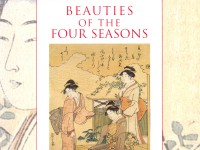Beauties of the Four Seasons
A full catalogue of the Ashmolean’s collection of Japanese bijinga (beautiful women) prints by Mitsuko Watanabe (published Oxford, 2005).

This catalogue is of two exhibitions devoted to one particular subject-matter of the Japanese woodblock print; figures of beautiful women, bijinga. These women are not depicted for their beautiful bodies, as perhaps they might be in the west, but for their beautiful faces and for their clothes. There is, or was, almost no interest in Japan in depictions of the nude, but the emphasis was upon the gorgeous kimono (literally 'the thing worn') and on the obi, the great sash and the various knots with which it was tied.
Bijinga are, then, to a great extent a fashion-plate, like a picture in a fashion magazine. The celebrated courtesans of the Yoshiwara were, of course, the leading 'models', but the clientele must have been much wider. The Yoshiwara, the licensed (and enclosed) pleasure quarter of Edo (Tokyo) was described as a 'floating world' (Ukiyo), a world of ephemeral pleasures, where the leading characters were the 'pop' figures of the day; the courtesans, from the senior Oiran through the middle-ranking Shinzo to the apprentices, the Kamuro, who are always depicted in pairs; the leading wrestlers; the kabuki actors and the tea-house girls.
Naturally the choice of kimono to be worn reflected the season; not only for reasons of comfort, for in winter kimono were padded, but also for the seasonal designs that adorn them; iris in summer or chrysanthemum in winter and so on. It was the custom to change the style of kimono four times in the year.
Depiction of the actual physiognomy was not all that important; the mid-eighteenth-century artist Suzuki Harunobu’s delicate girls all look remarkably alike, and yet one can usually recognise his favourite model, the tea-house attendant Osen is minimalism descends from the Yamato-e tradition, the 12th-14th century handscrolls, where the faces were 'a hook for the nose and a dash for the eye',but it was to be challenged later in the century by the great Kitagawa Utamaro, with his bust portraits of beautiful women. Utamaro did not invent the idea of the bust portrait, a great innovation, but it was he who exploited it to the full in bijinga.
Utamaro's women display emotion; the pursed lips, the tense poses; this was something new. This is not the same as the drama of Kabuki actors striking a particular pose and holding it for the effect, but a true attempt at individualism. Perhaps this owes something to the fact that Utamaro lived in the Yoshiwara in the 'Green Houses', just as Henri de Toulouse Lautrec was to do in Paris later.
Frequently the view is oblique; the back of the neck was considered particularly attractive, not to say erotic, and many Utamaro bust portraits are shown from or almost from the back. This may have been partly due to the vanity of the block-cutters and the printer, for the depiction of the hair was made with more than one block, so that the lines can cross each other, giving a delicacy otherwise unobtainable.
Japanese prints are the product of four collaborators; the publisher who commissioned the artist and chose the craftsmen to make the print; the artist who drew a preparatory drawing (shita-e), indicating the details and the colouration rather than drawing them fully; the block-cutter who prepared the ten or more colour blocks necessary for the full colour print, and the printer who actually printed them. In many ways, the final version of the print owes almost as much to the block-cutter, who was allowed a great deal of freedom, and to the printer who to a great extent controlled the final colouration, as it does to the artist who made the design.
The prints in this catalogue and in the successive exhibitions in the Ashmolean Museum have been selected and catalogued by Mitsuko Watanabe from the collections in the Department of Eastern Art. The majority of the prints come from the collection of Herbert Jennings, given to the Department by H.N. Spalding; Jennings as a collector was more interested in the delineation of the prints, at least of the eighteenth century prints, than he was in their condition. He therefore acquired a considerable number of prints that were retouched or recoloured, [see EAX.4731]; this was a most unusual thing to do in the 'thirties when Jennings was collecting. And it has taken some courage on the part of Ms Watanabe to exhibit them; but the point is, that this exhibition is about beautiful women, about fashion and about the changing seasons.
We are grateful to Mrs Aki Shann, who helped us with the identification of re-colouring, and to sponsors, Ono Group and Feng Sushi.
Notice
Object information may not accurately reflect the actual contents of the original publication, since our online objects contain current information held in our collections database. Click on 'buy this publication' to purchase printed versions of our online publications, where available, or contact the Jameel Study Centre to arrange access to books on our collections that are now out of print.
© 2013 University of Oxford - Ashmolean Museum
